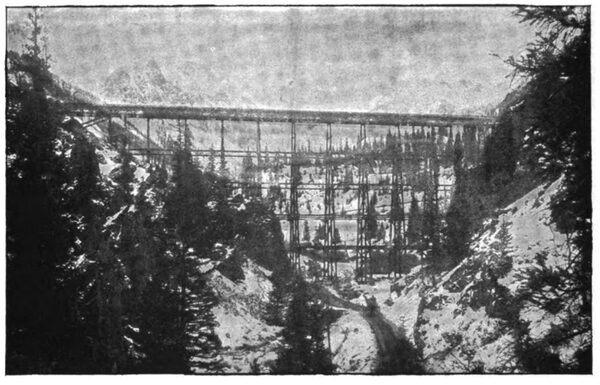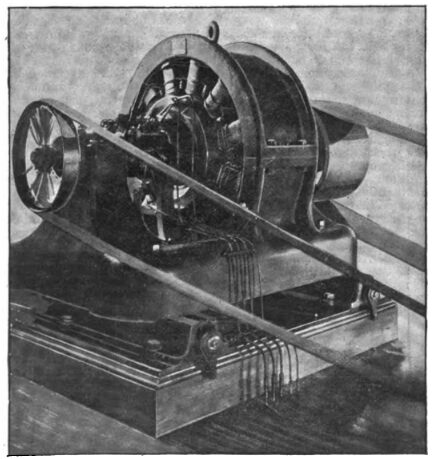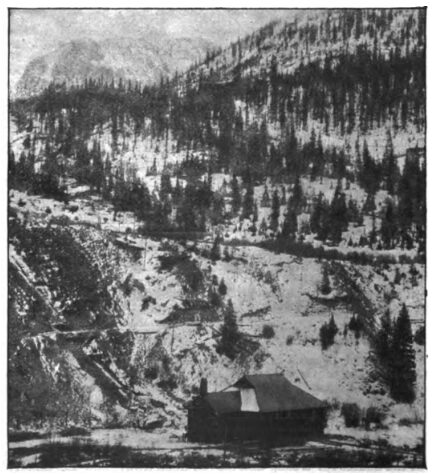[Trade Journal]
Publication: The Electrical Engineer
New York, NY, United States
vol. 20, no. 382, p. 218-219, col. 1-2
| |||
| Fig. 1. — Flume and Trestle, Silver Lake Mines, Col., Three-Phase Transmission Plant. |
THREE-PHASE TRANSMISSION PLANT AT THE
SILVER LAKE, COL., MINES.
An interesting application of the three-phase system of long distance transmission of power has recently been carried out at the Silver Lake Mines, near Silverton, Col. where power is transmitted a distance of three miles through some of the roughest country in Colorado. It is attracting considerable attention among mining men, as it is the first three-phase plant installed in the Rocky Mountain region.
The Silver Lake group of mines owned by Edward G. Stoiber, lie about four miles southeast of Silverton, and are situated at an altitude of 12,800 feet above sea level. The ore mined carrie [sic] carries both gold and silver, is of a comparatively low grade and requires concentration. Previous to the installation of electricity, the mill which is situated on the shores of the Lake, near the mouth of the mine tunnel, was run by steam. Coal was brought to the steam engine by a tedious path up the mountain, and by the time it reached the furnace cost $8.75 a ton. This represented a monthly expenditure of almost a thousand dollars, and the expense proved a burden which went far to eat up the profits of the mine. A change, therefore, became imperative.
The plant is now operated by water power, which is brought from the Animas River, above Silverton, through a 3 x 4 foot flume 9,750 feet in length, which carries 2850 cubic feet of water sper [sic] per minute. The flume and trestle are shown in the accompanying engraving Fig. 1. One of the great advantages of electrical utilization is here demonstrated for it was found less expensive to build this costly two mile flume, running from above Silverton down to a spot where the necessary head could be utilized, and then to transmit the electricity back to the mine, rather than to continue to burn coal at the price which it brought at the mouth of the Silver Lake Mines. The head of water obtained is about 180 feet, which develops on the water-wheel shaft 640 H. p.
| |||
| Fig. 2. — Three-Phase Generator, Silver Lake Mines, Col. |
The plant consists of two 4-foot double-nozzle Pelton water wheels with special buckets belt connected to two 150 K. W. General Electric three-phase generators, one of which is shown in Fig. 2. The current from these machines is delivered at 2,500 volts and is transmitted over a distance a little more than three miles to the Silver Lake mill and mine.
The conductors are No. 3 B. & S. bare copper wires, one for each branch of the three-phase circuits. These are strung from the power house, shown in Fig. 3, up the mountain passes and through the rugged country. In one place where a chasm has to be spanned the wires are strung on poles 275 feet apart. The conductors have been strung with especial care as required by the abnormal conditions. At each insulator the wire is run through a short piece of rubber tube as an extra precaution against leakage. Lightning arresters are placed at each end of the line and an additional safeguard against damage by lightning is provided in the shape of a barbed iron wire which extends the entire distance of the line along the tops of the poles and is grounded at every second pole.
| |||
| Fig. 3. — Power House, Silver Lake Mines, Col. |
Arriving at the mine the current is supplied to a 100 H. P. three-phase induction motor run directly from the primary circuit. Another 100 H. P. motor, as well as one of 75 H. P. are located beneath the ground and current is supplied to these at a pressure of 220 volts, the reduction in pressure being effected by step-down transformers. In addition, a 15 H. P. motor runs a pump raising water from the Lake to the mill, and one small 1 H. P. motor operates a blower and the lights for a bunk, office and other buildings, both being connected to the secondaries. The General Electric induction motors are used.
The interest in this mine centres, of course, upon the economy effected by the electrical installation. The power used in the mill and the mines at the present time, is more than three times as much as that generated by the steam engine previously employed.



